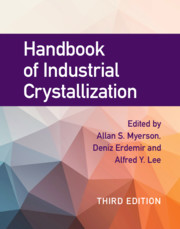Book contents
- Handbook of Industrial Crystallization
- Handbook of Industrial Crystallization
- Copyright page
- Contents
- Contributors
- Preface to the First Edition
- Preface to the Second Edition
- Preface to the Third Edition
- Chapter 1 Solutions and Solution Properties
- Chapter 2 Crystals and Crystal Growth
- Chapter 3 Crystal Nucleation
- Chapter 4 The Influence of Impurities and Additives on Crystallization
- Chapter 5 Molecular Modeling Applications in Crystallization
- Chapter 6 Crystallization Process Analysis by Population Balance Modeling
- Chapter 7 Selection and Design of Industrial Crystallizers
- Chapter 8 Precipitation Processes
- Chapter 9 Melt Crystallization
- Chapter 10 Crystallizer Mixing
- Chapter 11 Monitoring and Advanced Control of Crystallization Processes
- Chapter 12 Batch Crystallization
- Chapter 13 Crystallization in the Pharmaceutical Industry
- Chapter 14 Crystallization of Proteins
- Chapter 15 Crystallization in Foods
- Chapter 16 Precipitation and Crystallization of Pigments
- Index
- References
Chapter 7 - Selection and Design of Industrial Crystallizers
Published online by Cambridge University Press: 14 June 2019
- Handbook of Industrial Crystallization
- Handbook of Industrial Crystallization
- Copyright page
- Contents
- Contributors
- Preface to the First Edition
- Preface to the Second Edition
- Preface to the Third Edition
- Chapter 1 Solutions and Solution Properties
- Chapter 2 Crystals and Crystal Growth
- Chapter 3 Crystal Nucleation
- Chapter 4 The Influence of Impurities and Additives on Crystallization
- Chapter 5 Molecular Modeling Applications in Crystallization
- Chapter 6 Crystallization Process Analysis by Population Balance Modeling
- Chapter 7 Selection and Design of Industrial Crystallizers
- Chapter 8 Precipitation Processes
- Chapter 9 Melt Crystallization
- Chapter 10 Crystallizer Mixing
- Chapter 11 Monitoring and Advanced Control of Crystallization Processes
- Chapter 12 Batch Crystallization
- Chapter 13 Crystallization in the Pharmaceutical Industry
- Chapter 14 Crystallization of Proteins
- Chapter 15 Crystallization in Foods
- Chapter 16 Precipitation and Crystallization of Pigments
- Index
- References
Summary
Crystallization is one of the most important separation and product-formation technologies in the chemical industry. Typical advantages of crystallization are the low energy consumption, mild process conditions, and high product purity that can be obtained in a single separation step. The future impact of crystallization is even expected to increase further because many new high-added-value products are often in crystalline form. However, future crystalline products are also subject to increasingly stringent product quality requirements related to, for example, flowability, filterability, bioavailability, stability, and dissolution behavior. Product quality requirements for crystalline products typically vary strongly depending on the field of application.
- Type
- Chapter
- Information
- Handbook of Industrial Crystallization , pp. 197 - 215Publisher: Cambridge University PressPrint publication year: 2019
References
- 3
- Cited by

